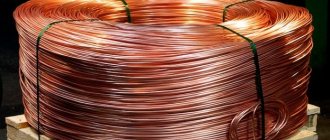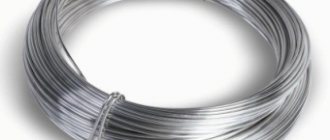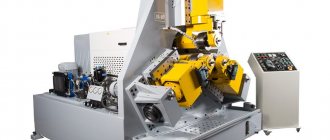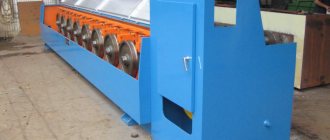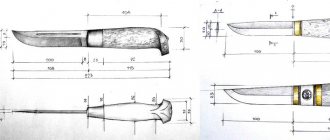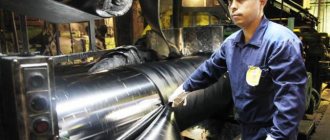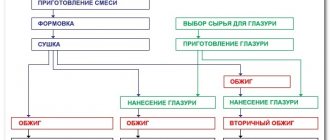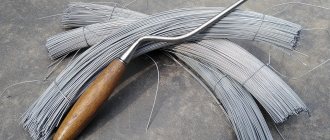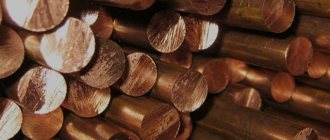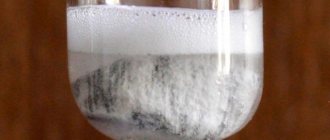§ 5. Wire drawer of the 2nd category
Characteristics of the work .
Drawing of copper and aluminum wire on drawing mills. Installing the wire on the carousel, threading its ends, pulling it through dies and securing it to the drums. Participation in setting up mills and changing dies. Securing the ends of the wire. Installing dies on the mills and threading the ends of the processed wire into the dies. Monitoring the quality of the emulsion. Measuring wire diameter. Must know: the operating principle of serviced drawing mills; rules for threading and securing the ends of the wire on the drums; purpose and rules of use of the used control and measuring instruments and devices; basic mechanical properties of processed metals; composition of lubricants used when drawing wire from various alloys; basic information about quality and roughness parameters.
§ 6. Wire drawer of the 3rd category
Characteristics of the work . Drawing of wire of all profiles with a diameter of up to 1.8 mm from low-carbon steel grades at a drawing speed of up to 300 m/min on single and multiple drawing mills. and from non-ferrous metals. Drawing wire from precious metals and their alloys with a diameter of over 0.09 to 1.0 mm. Welding wire on an electric welding machine. Adjustment and maintenance of lubricating and special winding devices, welding machines, removable mechanisms and drawing cooling systems. Setting and regulation of drawing speed along a given route and drawing mode. Drawing on single and multiple drawing mills of wire with a diameter of over 1.8 mm from low-carbon steel grades at a drawing speed of up to 300 m/min, drawing of wire from non-ferrous metals and alloys with a diameter of over 1.8 to 6 mm under the guidance of a wire drawer of a higher qualification . Removing and tying coils of wire. Preparing skeins and bobbins for drawing. Monitoring the quality of wire winding on the receiving device. Tying of bundles, installation and removal of coils (drums). Adjustment of serviced drawing mills.
Must know: the structure, rules for adjustment of various types of drawing mills and other equipment for drawing; arrangement of the used control and measuring instruments and special devices; procedure for installing and changing dies; basic properties of metals and alloys processed under pressure; wire grades; basic information about quality and roughness parameters.
§ 9. Drawer of non-ferrous metals, 3rd category
Characteristics of the work . Conducting the process of drawing pipes, strips, rods, profiles from non-ferrous metals and alloys on single-strand chain drawing mills with a force of up to 25 tf. Rolling pipes on the rod and removing the rod. Conducting the process of drawing products from non-ferrous metals and alloys on single-filament chain drawing mills with a force of 25 tf to 50 tf under the guidance of a non-ferrous metal drawer of higher qualification. Control of product dimensions during processing. Adjustment of serviced equipment and tools.
Must know: the structure of the equipment being serviced, the devices used, instrumentation and tools; the basic properties of non-ferrous metals and alloys; types and properties of lubricants used.
§ 7. Wire drawer of the 4th category
Must know: the structure, kinematic diagrams and rules for setting up drawing mills and other equipment for drawing; rules for determining the amount of reduction along the passes of drawing mills and drawing speed; technical specifications for the raw materials used and manufactured products; methods of influence of etching and annealing on the quality of metal during drawing; rules defining the sequence of wire drawing and the number of broaches for certain metals; design of special devices; basic information about quality and roughness parameters.
§ 10. Drawer of non-ferrous metals, 4th category
Characteristics of the work . Conducting the process of drawing pipes, strips, rods, profiles from non-ferrous metals and alloys on single-strand chain drawing mills with a force of 25 tf to 50 tf, mandrelless pipe drawing on drum-type mills. Drawing of pipes made of precious metals. Conducting the process of drawing pipes, strips, rods, profiles made of non-ferrous metals and alloys on single-thread chain drawing mills with a force of 50 tf and above, on double lines of triple drawing, multi-thread mills and pipes on a floating mandrel on drum-type mills under the guidance of a non-ferrous metal drawer of higher qualifications. Control of the workpiece feeding conveyor, lifting and setting table, automatic carriage and gripping mechanism. Regulation of drawing speed depending on processing technologies.
Must know: design features of the equipment being serviced; technology for processing products made of non-ferrous metals and alloys; design of used instrumentation and tools; state standards and technical specifications for manufactured products; plumbing.
§ 8. Wire drawer of the 5th category
Characteristics of the work . Drawing on single and multiple drawing machines: wires with a diameter of over 1.8 mm from low-carbon steel grades at a drawing speed of over 300 m/min; wires with a diameter of over 1.8 mm from medium-carbon, high-carbon and alloy steel grades; wires made of non-ferrous metals with a diameter of over 6.0 mm; wires made of resistance alloys and stainless steel grades; flux-cored wire and wire rod with mechanical descaling. Repeated drawing of tungsten, molybdenum and tantalum wire at grade 6. Drawing wire from precious metals and their alloys with a diameter of up to 0.02 mm. Wire drawing on high-speed mills with individual DC drives.
Must know: the design of drawing mills of various types; types of wire drawing and number of broaches for various metals; wire drawing technology; composition of the emulsion supplied to the drawing mills.
§ 11. Drawer of non-ferrous metals, 5th category
Characteristics of the work . Conducting the process of drawing pipes, strips, rods, profiles from non-ferrous metals and alloys on single-thread chain drawing mills with a force of 50 tf and above, on double lines of triple drawing, multi-thread mills and pipes on a floating mandrel on drum-type mills. Participation in the adjustment of electrical, pneumatic and mechanical circuits of the mill when moving from one size to another. Regulation and control of drawing speed in accordance with drawing technology and the condition of the metal and alloy being processed.
Must know: kinematic, electrical, pneumatic circuits and design of the equipment being serviced; technology for processing products along the drawing route.
Comments on the profession
The given tariff and qualification characteristics of the profession “Wire Drawer” serve for the tariffication of work and the assignment of tariff categories in accordance with Article 143 of the Labor Code of the Russian Federation. Based on the above job characteristics and the requirements for professional knowledge and skills, a job description for a wire drawer is drawn up, as well as documents required for interviews and testing when hiring. When drawing up work (job) instructions, pay attention to the general provisions and recommendations for this issue of ETKS (see section “Introduction”).
We draw your attention to the fact that the same and similar names of working professions may appear in different issues of ETKS. You can find similar names through the directory of working professions (alphabetically).
Source
